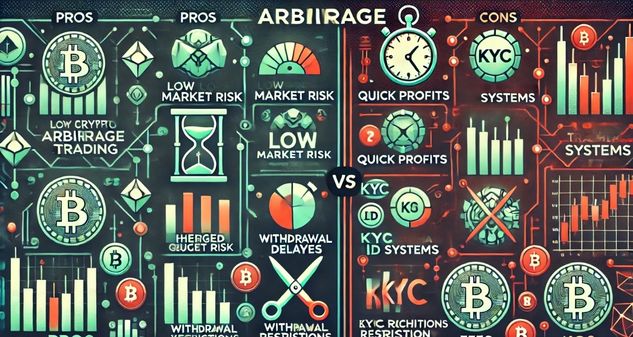Cryptocurrency markets are famous for their volatility, decentralization, and rapid evolution. While this unpredictability scares off some investors, it also opens the door to sophisticated strategies for those willing to do their homework. One such strategy is crypto arbitrage trading, a method that capitalizes on price differences of the same asset across different exchanges.
Unlike traditional trading, which often involves forecasting market direction, arbitrage is direction-neutral. It doesn’t rely on bullish or bearish trends but rather on identifying inefficiencies across platforms or regions. For instance, Bitcoin might be trading at $29,800 on Binance and $30,050 on Coinbase. A savvy arbitrage trader could buy on the lower-priced exchange and simultaneously sell on the higher-priced one, pocketing the difference.
Although it sounds simple in theory, arbitrage trading in the crypto world involves complexities such as timing, fees, liquidity, and regulation. In this guide, we’ll break down the ins and outs of crypto arbitrage trading—how it works, key strategies, real-world examples, and how tools like Arbiquant are helping traders automate and optimize their arbitrage workflows.
What Is Crypto Arbitrage?
Crypto arbitrage refers to the practice of buying a cryptocurrency on one platform at a lower price and simultaneously selling it on another at a higher price to profit from the difference.
Why Price Differences Exist
Several factors contribute to price discrepancies between exchanges:
- Geographical demand variation
- Liquidity differences
- Lag in data updates
- Exchange-specific fees and spreads
- Regulatory restrictions in certain markets
These price gaps, although often small (1–3%), can be highly profitable when executed at scale or with automation.
Types of Crypto Arbitrage Strategies
Spatial Arbitrage (Exchange Arbitrage)
This is the most common form. Traders exploit price differences between two or more centralized exchanges (e.g., Binance vs. Kraken).
Example: Buy ETH on KuCoin at $1,780 and sell it on Coinbase at $1,795.
Triangular Arbitrage
Involves trading three cryptocurrencies on the same exchange to take advantage of discrepancies between their relative exchange rates.
Example: BTC → ETH → USDT → BTC
This strategy is ideal for minimizing withdrawal fees, as all trades happen within one platform.
Decentralized Arbitrage
Exploiting differences between decentralized exchanges (DEXs) like Uniswap, SushiSwap, or PancakeSwap.
Risk: Higher slippage and gas fees.
Statistical Arbitrage
A more advanced method using mathematical models and bots to identify temporary mispricings across correlated assets or markets.
Tools like Arbiquant offer AI-based monitoring and execution for these trades, helping traders act on micro-inefficiencies in milliseconds.
Benefits and Risks of Arbitrage Trading

Pros
- Low Market Risk: Since trades are hedged, arbitrage avoids directional exposure.
- Quick Profits: Trades typically close in minutes or even seconds.
- Data-Driven: Success relies more on speed and systems than speculation.
Cons
- High Competition: Opportunities vanish fast as bots dominate.
- Withdrawal and Transfer Delays: Slower blockchain networks can destroy profit margins.
- Exchange Restrictions: KYC requirements and withdrawal limits can hinder execution.
- Fees: Network, trading, and withdrawal fees can eat into profits if not carefully managed.
Real-World Examples and Case Studies
Case Study 1: South Korean “Kimchi Premium”
During 2017 and parts of 2021, crypto prices in South Korea were 10–15% higher than global averages. Arbitrage traders took advantage of this premium by buying BTC internationally and selling it on South Korean exchanges. While profitable, it required navigating tight capital controls and legal gray zones.
Case Study 2: USDT Arbitrage
In 2020, USDT often traded at a premium in high-demand countries like Nigeria due to currency restrictions. Traders could purchase USDT from global exchanges and sell locally at a markup via peer-to-peer platforms.
Tools & Platforms for Arbitrage Success
Success in crypto arbitrage depends heavily on speed and automation. Manual trading is too slow for most opportunities. That’s where software like Arbiquant comes in.
Features to Look For in Arbitrage Tools:
- Real-time data monitoring
- Multi-exchange integration
- Instant trade execution
- Customizable strategies and thresholds
- Risk management alerts
These platforms often come with backtesting and performance tracking features, allowing users to fine-tune their approach.
Best Practices for Crypto Arbitrage
- Keep Funds Pre-Distributed: Maintain balances on multiple exchanges to avoid withdrawal delays.
- Monitor Fees Constantly: Include gas fees, exchange fees, and slippage in calculations.
- Use Stablecoins: Trading in USDT or USDC helps avoid price fluctuations.
- Stay Compliant: Know your tax obligations and local laws.
- Automate When Possible: Manual trades are prone to delays and errors.
FAQs

What is the minimum capital required for crypto arbitrage?
While you can start with as little as $100, higher capital improves profit potential and absorbs fees better.
Is crypto arbitrage legal?
Yes, in most countries. However, some jurisdictions may restrict cross-border transfers or arbitrage behavior.
How fast do you need to be?
Milliseconds matter. The fastest traders typically use bots or algorithmic tools.
Can you do arbitrage with decentralized exchanges?
Yes, but beware of high gas fees, especially on Ethereum-based DEXs.
Do I need accounts on multiple exchanges?
For spatial arbitrage, yes. Keeping verified accounts ready speeds up execution.
Are there risks of slippage?
Yes, especially during high volatility. Prices can change before your trade is completed.
What’s the role of bots in arbitrage?
Bots can scan thousands of opportunities per second and execute trades faster than any human.
Do fees cancel out arbitrage profits?
If not managed carefully, yes. Always include all fees in your profit calculations.
Is arbitrage still profitable in 2025?
Yes, but opportunities are more competitive and require automation, especially for low-margin trades.
How can I track opportunities efficiently?
Use dedicated platforms like Arbiquant, which offer real-time alerts and AI-driven analysis.
Conclusion
Crypto arbitrage trading represents a fascinating blend of finance, technology, and strategy. While not as glamorous as trend trading or as dramatic as futures, it offers consistent, relatively low-risk opportunities for those who understand its nuances. As global crypto adoption continues to rise, price discrepancies—although smaller—persist across geographies, exchanges, and platforms.
Mastering arbitrage means mastering execution speed, fee calculation, and automation. And with advanced tools like Arbiquant, even retail traders can access institutional-grade technology to optimize their trades.
In a market as unpredictable as crypto, arbitrage stands out as a strategy based not on hope, but on logic and precision. For disciplined, data-driven traders, it could be one of the most sustainable paths to long-term profitability.
See Also: Crypto Calendar: How It Helps Investors Make the Right Decisions










